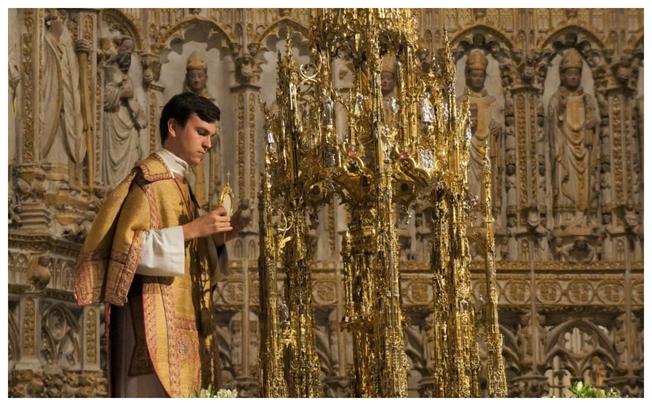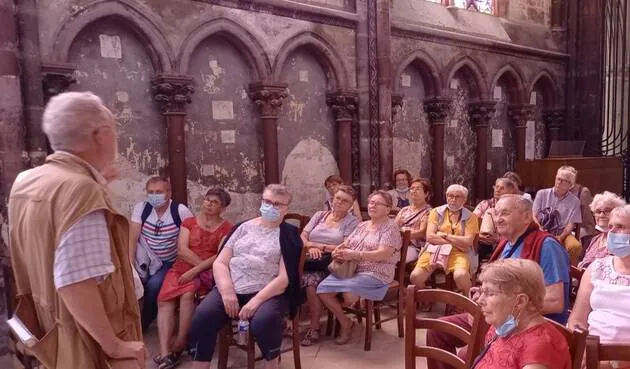Custody Toledo: Corpus. The worst sectarianism
Today is the day of Corpus Christi, and the good and the bad come to mind, the adoration and the sacrileges committed against the Holy Eucharist. Neither the martyrdom of people nor that of sacred things, being all this a set of many and serious crimes, was the worst thing that the socialists, communists and anarchists did during the Spanish Civil War.
The truly terrible thing was the desecration of the Eucharist. Undoubtedly, it is this sacrilege against the Body of Christ that clearly reveals the satanic impulse that encouraged the anti-religious sectarianism of socialists, communists and anarchists, responsible for the greatest persecution of the Catholic Church of all time. .
It happens that some cloistered nuns from Toledo are kidnapped to be shot, they go joyfully to their martyrdom and when they get rid of death at the last moment they are left disappointed because they consider that they have not been worthy of receiving the palm of martyrdom.
In the days before this event they have insulted them, they have stolen their belongings, they have humiliated them, they have outraged them, they have taken advantage of them and they have turned them into slaves in the houses of the socialists of the town where they force them to work without pay... And despite everything they don't break.
But the situation changes when they desecrate the Eucharist. This is how one of the newspapers published in that eloquent book entitled The desecration of the female cloister, noted by Jorge López Teulón, a good connoisseur of religious persecution during the Spanish Civil War, tells us: “It was July 25, 1936, Saturday and feast of Santiago Apóstol, patron saint of Spain. Five days ago the so-called red militiamen had come to search our little house and thereby disturb our peace. The rudeness with which some of them behaved and the threatening words they said to us when they said goodbye, sowed a horrible panic in the community and persuaded us that, more or less later, we would be victims of Marxist barbarism. They had the courage, Oh God!, to thoroughly search even the sacred vessels; What's more, and I tremble when I write it, their impious audacity reached the point of opening the tabernacle and with their sacrilegious hands touching the Sacred Forms that they scattered on the altar, while we, overwhelmed with grief and horrified, wept without consolation”.
You can understand those tears at the desecration of the most precious treasure that we Christians have. For that same reason from the beginning the Church sought the best for the Lord. This is how Holy Mary taught the apostles with her life, because that valuable seamless tunic that Christ was stripped of in the Passion was obtained by his Mother, if she did not knit it herself. And Mary Magdalene, following the example of Saint Mary, poured out that priceless perfume bottle on the Lord, in the midst of hypocritical criticism, which after two thousand years continues to be repeated with the same arguments.
On October 2, 1264, Pope Urban IV proclaimed Corpus Christi Day as a holiday for all of Christianity and commissioned Saint Thomas Aquinas to write the official letter for that religious holiday. And without a doubt that since then, in this homeland of ours which is the land of Mary, the Spanish and especially the Catholics of Toledo have celebrated that day with special solemnity.

On the contrary, it is understood that anti-religious sectarianism tried to make one of the Eucharistic symbols of Spain disappear, such as the custody of Arfe from the cathedral of Toledo, although the socialists and communists did not succeed, as they did they achieved with a good part of the treasure of the cathedral of Toledo. On September 4, 1936, it was packed in nine boxes that ended up in 1939 on the famous ship Vita, a large-capacity ship that was 62 meters long and 9 meters wide. It had been bought by Marino Gamboa, a character from the PNV environment who put him at the service of the Government of the Republic, to commit this crime.
The treasure of the cathedral of Toledo was only a small part of the extremely valuable cargo of incalculable value that the Vita transported to Mexico, in February 1939, where it disappeared. The Republican government put Captain José de Ordorica, related to the PNV, at the helm of the Vita, but the real person in charge of it was the socialist Enrique Puente Abuín. So that, as at present, the socialists and the Basque independentistas are partners, everything will be easy so that Carmen Calvo, the Minister of Historical Memory, in the fulfillment of her position, revealed to us who benefited from the immense theft of the Life.
What happened with Arfe's custody has been masterfully described by Jorge López Teulón in one of his books, in which he recounts how religious persecution was in the Archdiocese of Toledo. I fully transcribe the quote, which is worth reading carefully because it tells in detail what the custody of Toledo is like and what they tried to do with it during the Civil War: "In the sacristy of the cathedral of Toledo everything is prepared for a new looting of the cathedral treasury. It is truly frightening to contemplate the walls of the sacristy without a single painting... Almost everything is already packed: El Greco's apostolate, Goya's "El prendimiento"... El Greco's "El Expolio", torn from its place, is waiting to be packed , while resting leaning on one of the bars of the Ochavo, behind the Chapel of the Virgen del Sagrario.
There are still two specialized workers left in one of the rooms, who are dismantling the famous custody of Enrique de Arfe. Even the most atheist in the city know the history of Corpus Christi and its Custody, defined as one of the greatest jewels of Christianity. A tower of more than two meters of gold and silver runs through the streets of Toledo every year during the Corpus Christi festival. Before murdering the canons Ildefonso Montero, treasurer of the Primacy, and the archdeacon Rafael Martínez, they made sure that they were provided with the manual for dismantling the Custody. It seems that the brilliant Enrique de Arfe, like a prophet, thought that perhaps this day of infamy and sacrilege would come, and when he finished his work in 1524 he wrote a manual to disassemble and reassemble the 5,600 pieces that make it up, using the corresponding 12,500 screws.
—Actually —says one of the workers who are being watched by a group of militiamen— there are two guards. In the central part there is a small Gothic-style monstrance, commissioned by Queen Isabella to be carved at the end of the 15th century by a Catalan jeweler, Almerique, who used 17 kilos of the first gold brought from America by Christopher Columbus, as well as of precious stones and various enameled figures.
—Then —he continues, while they are dismantling the interior monstrance of the Queen— Cardinal Cisneros ordered the purchase of this small monstrance of Isabella the Catholic, giving it to the Cathedral in 1505. The final result of this new monstrance was a complicated set of openwork pilasters joined by arches with filigrees and needles to form a small temple in the shape of a Gothic tower.
"Yeah, yeah," the second one answers, between annoyed and tired from work. Some compare the Custody with the tower of the Cathedral of Toledo... But for now, to dismantle it, we have had to prepare a scaffolding for its two and a half meters in height. Of course, to move it, in the drawers and separately the 183 kilos of silver, the 18 of gold and the 260 statuettes will be better distributed. Well, that's if you don't get distracted!
—No wonder they're so interested!
—Now, rest assured that what doesn't travel is the virile, because the one who seems to be the leader has put it in the pocket of his overalls.
—Shut up and finish! That we still have to take all the photos, to deliver them in Madrid.
The obituary of Julio Pascual, which appeared on ABC on December 8, 1967, affirms that "the last ironworker, forger and artificer of contemporary Spain" had died and that "his greatest professional bitterness and joy occurred in 1936 and in 1939. That is to say, when he was forced by the republican authorities to dismantle the custody of Arfe from the cathedral of Toledo, which, duly packed, they were preparing to take out of Spain, and later, when commissioned by Cardinal Gomá, he was requested his proverbial mastery to once again carry out the assembly and restoration of the monumental jewel.
Eduardo Sánchez Butragueño writes: “Fortunately for the paintings and custody, due to the advance of Franco's troops towards Toledo, the Republican authorities did not complete the seizure of all the packed items. The monstrance was located inside the cathedral in boxes, after the capture of the city by General Varela and Cardinal Gomá commissioned Julio Pascual to assemble it again.
Without a doubt, Pascual did something within the reach of very few: assemble and disassemble this colossal goldsmith monument with the help of the manual written by Arfe”.
What happened to the virile of the Monstrance of Isabel la Católica, which is the part of the Monstrance with which the faithful are blessed (for example, in Plaza Zocodover), was told by the official chronicler from the province of Toledo, Mr. Luis Moreno Nieto, who remembered him on the pages of ABC on May 28, 1964:
“For twenty-seven years the famous Custody of Enrique de Arfe has been parading through the streets of the Imperial City with its most valuable piece devoid of the precious stones that enriched it, since twenty emeralds and eighty pearls were extracted at the point of a knife. The sacrilegious plunder has been repaired by the Cathedral Chapter, and this year the colossal jewel —this is how Galdós described the custody of Toledo—, intact and complete, will once again carry the Lord in the Corpus Christi procession before thousands of outsiders, who will be It is possible to contemplate, without destruction or mutilation, the best throne of Christ carved by the hands of men.
Shortly after the red domination of 1936 in Toledo, when the only two surviving canons took charge of the cathedral treasury, among a pile of rubble, behind the double iron door that protects the room, they found two drawers with the parts principals of custody ready to be transferred to Madrid by order of Giral; The monstrance was found among some papers belonging to the Marxist civil governor, but without a single one of the stones that enriched it and which were then valued at two and a half million pesetas. All the efforts that Cardinal Gomá made then to recover the stolen stones were useless. Since then they have tried to replace them.
The Cabildo, using one hundred emeralds and as many pearls from other jewels and donations kept from the Cathedral for centuries, carried out the difficult task in 1964.
Javier Paredes
Professor of Contemporary History at the University of Alcalá.


